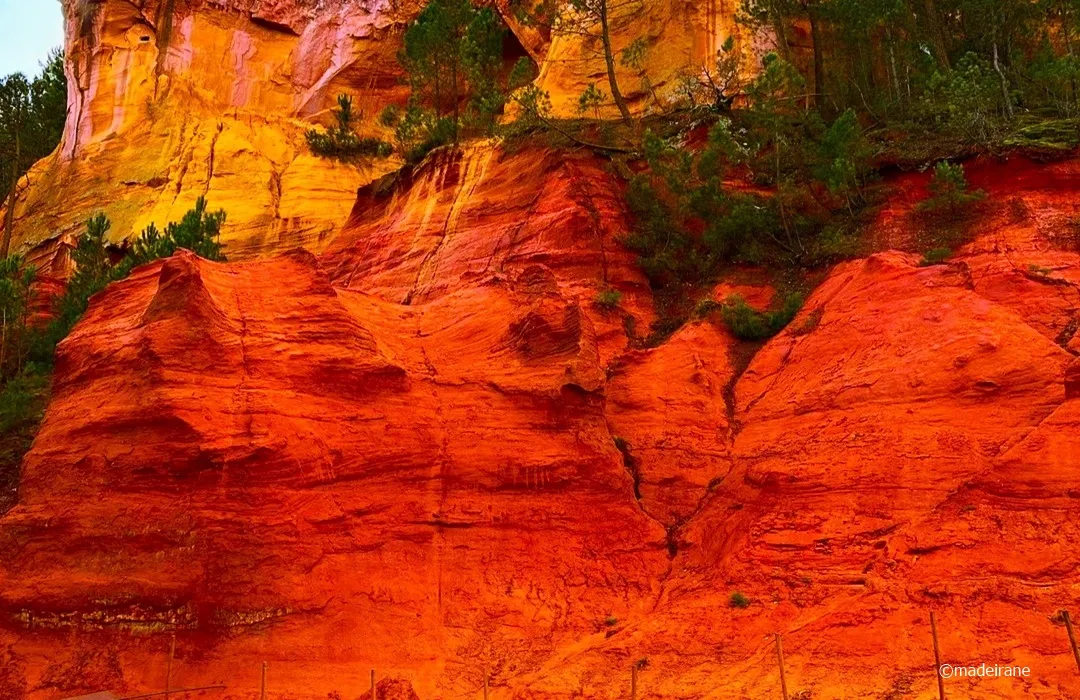
Having examined the city of “Fifty Shades of Ocher” Roussillon, we went to the Ocher Quarries, located on the very outskirts of the city. And if you see red-orange cliffs against a backdrop of bright green pine trees in any photograph or postcard, you know that this is probably the Ocher Reserve in Provence.
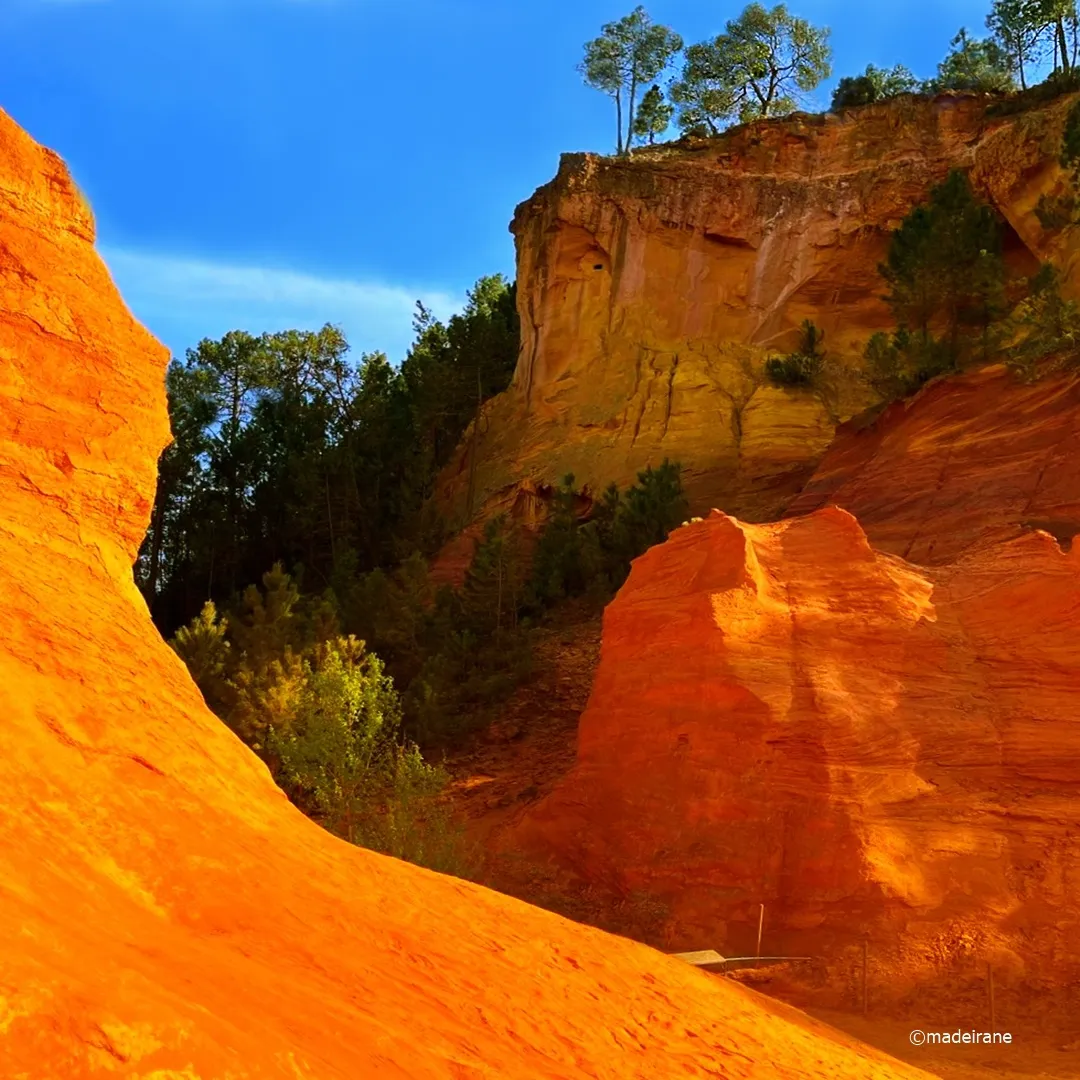
Once upon a time, there were simply quarries where ocher was mined - the famous mineral pigment from light yellow to brownish-yellow. It is also called “brown iron ore.” Ocher is generally a mixture of iron hydrate oxide and clay. Basically, natural ocher is yellow, but red ocher is obtained by burning yellow ocher.

There is one parking lot closer to the village of Roussillon and one closer to the entrance to the reserve - it’s important not to make a mistake here, because it takes about 30 minutes to walk from one parking lot to another!
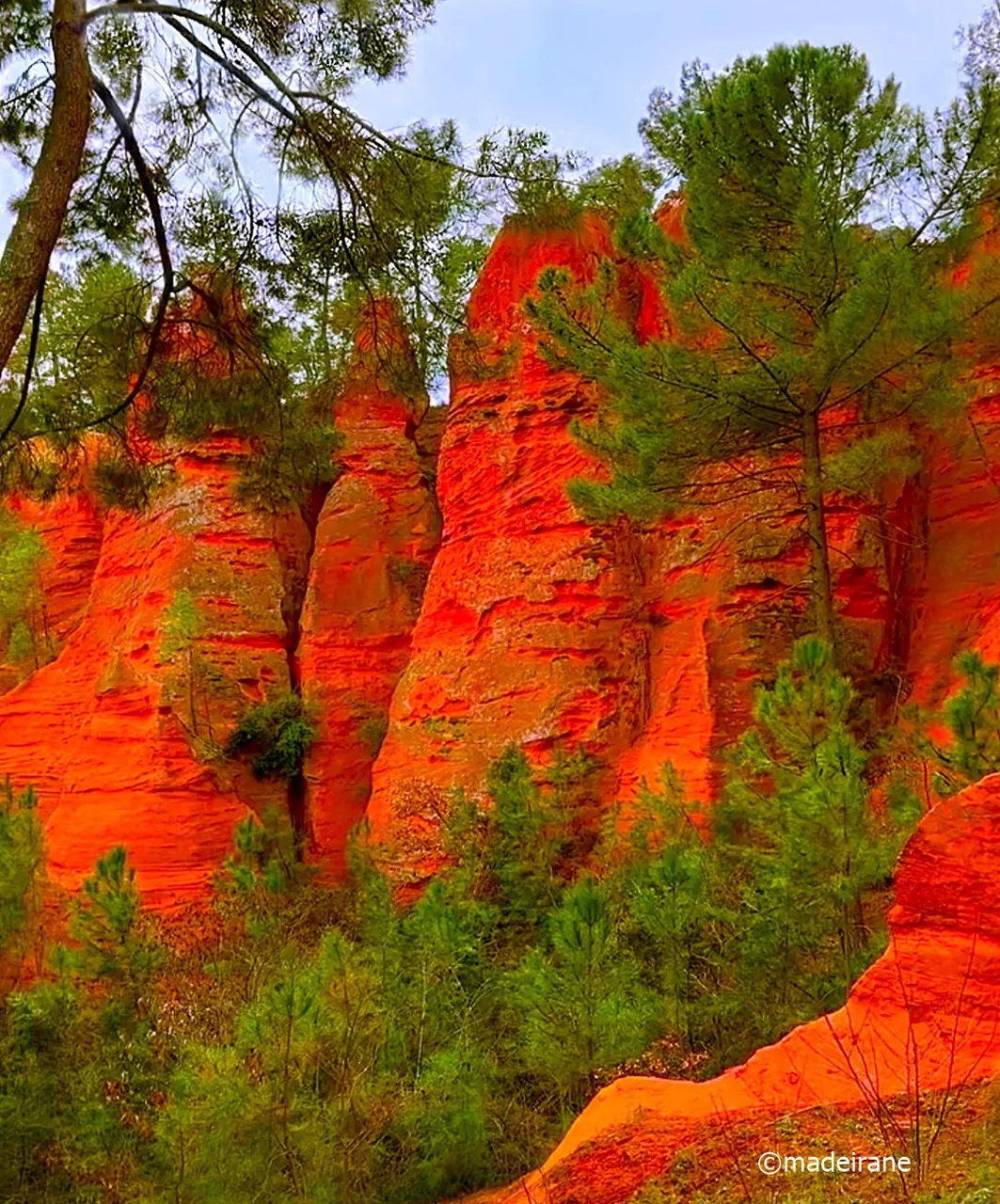
By the way, the brochure that is given out at the entrance to the Ocher Reserve also says that in the same region, not far from the quarry, there is an old factory for the production of ocher pigment. Anyone interested can also visit. I can’t give any advice in this regard, since we limited ourselves to only a quick inspection of the town of Roussillon and the Reserve itself.
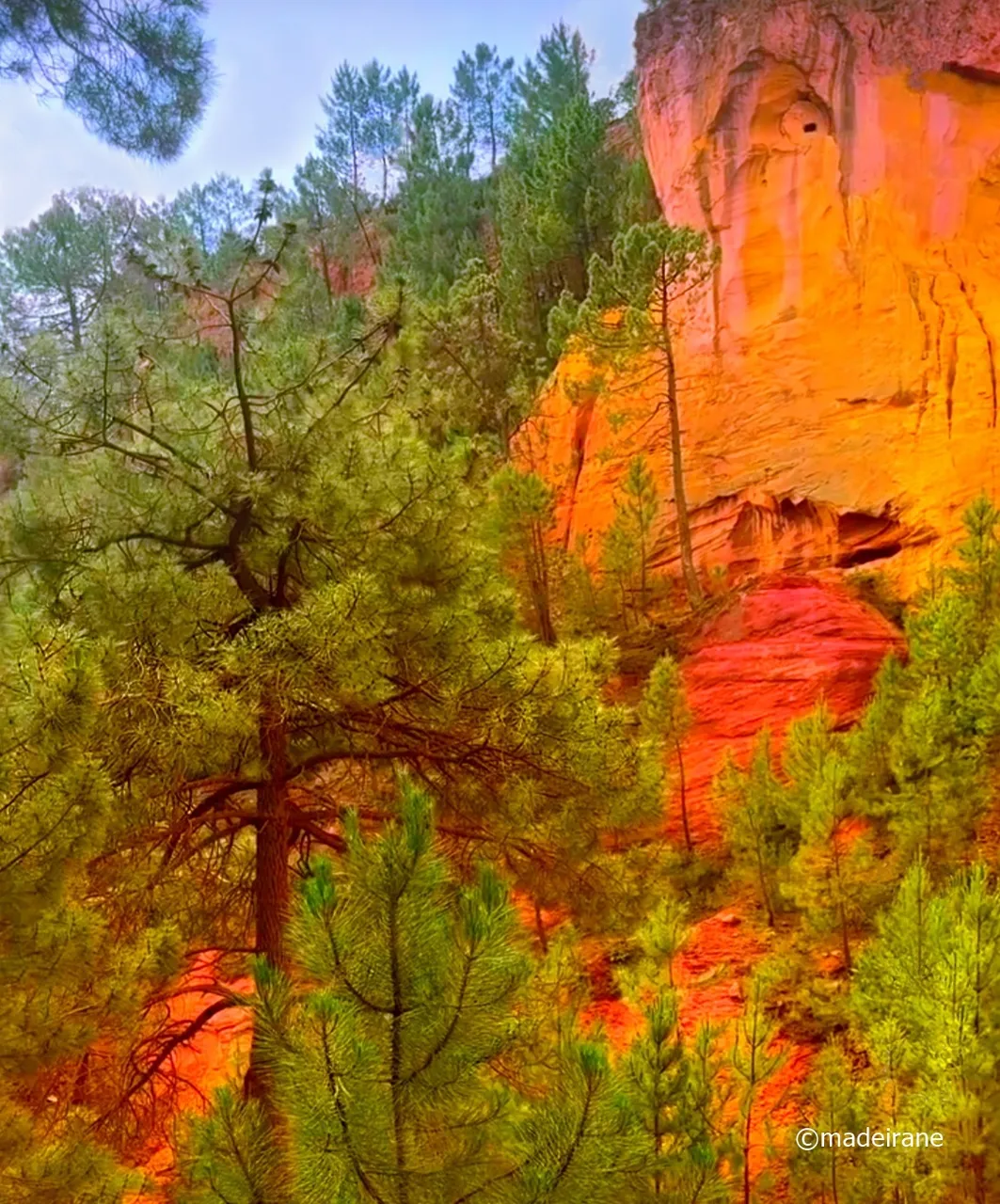
All these cliffs remain from former quarries where ocher was mined for many years, from the 18th century until 1930. By the way, these were the largest ocher quarries in Europe, but with the advent of modern acrylic and other synthetic paints, ocher mining decreased and later disappeared completely. To support and finance the town of Roussillon, local authorities turned the abandoned canyon into a tourist attraction. To this day, this province attracts tourists who want to look not only at the Ocher Reserve, but also at the town located nearby.
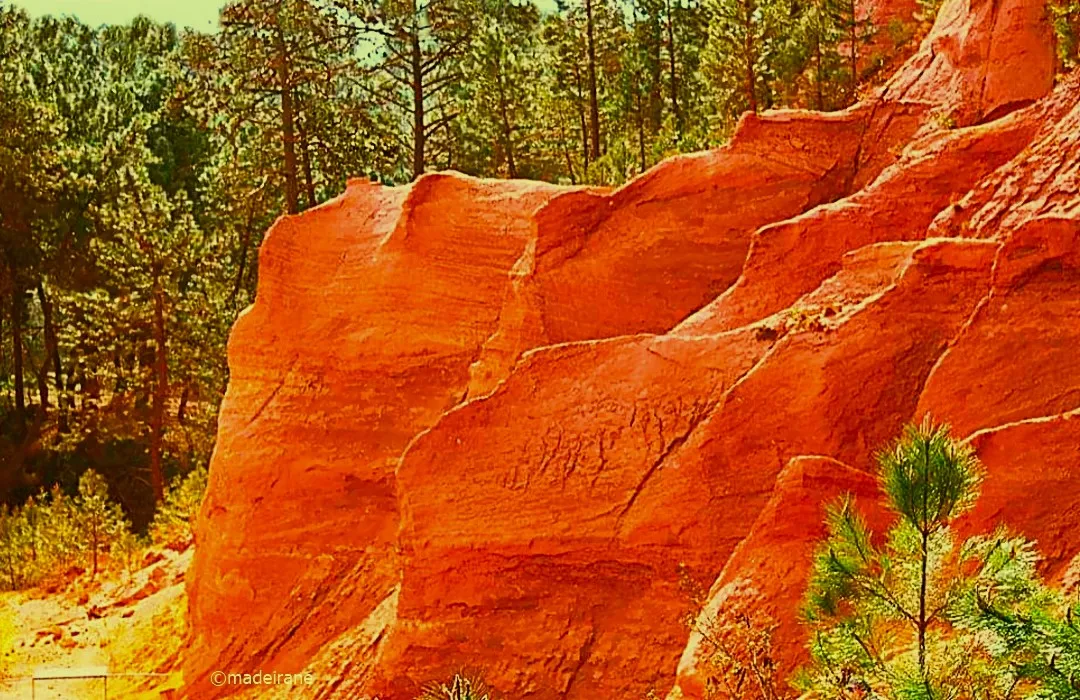
We buy tickets, go through the turnstiles and find ourselves in a place of extraordinary, mesmerizing beauty. The first glimpse of the Quarry can be taken from the Roussillon road. If you don't have much time, I would advise you better to skip the city tour, because the quarries turned out to be much, much more interesting and amazing!
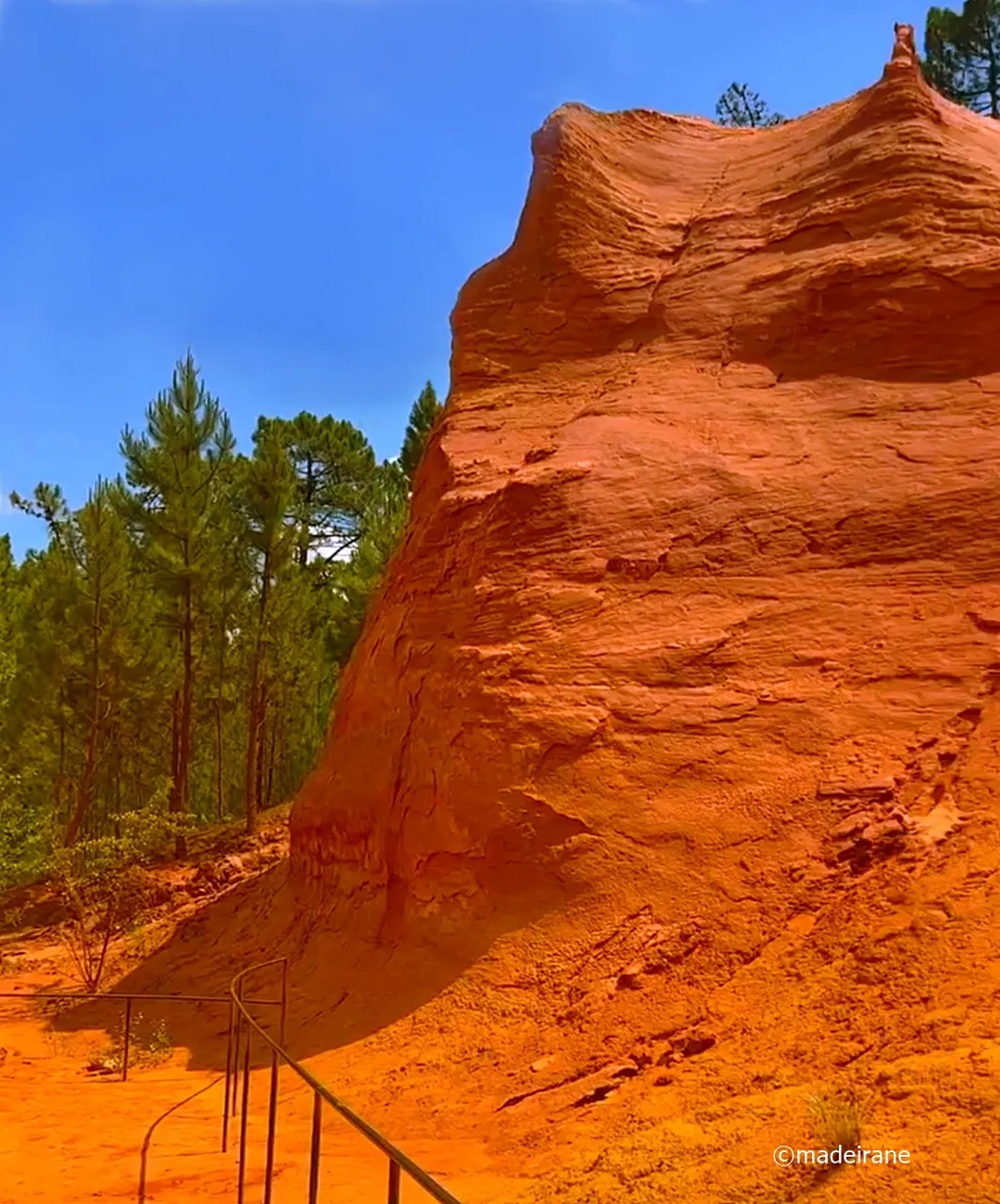
When purchasing tickets, each visitor is given a map on which the routes are marked. There are two in total: yellow and red. The yellow route is shorter, the red one is correspondingly longer and follows from the yellow one, being its harmonious continuation. If you choose the long red path, the walk will not take a long time, maximum 30–40 minutes at a leisurely pace.

So, a good staircase, covered with orange dust, leads down. The most magical photo would come from it, if not for the impatient tourists pressing behind us. The path winds among hills and trees, the trunks of which are covered with a red coating.

We went down the stairs hearing the admiring oohs and aahs. On one side we have a red rock, on the other - a cliff with a mixture of orange-red and deep green colors. Right in the middle, the sand is so bright orange that it’s hard to believe.

The uniqueness of the ocher reserve in Roussillon lies precisely in the fact that here you can see pale yellow, deep yellow, orange, pinkish, red and even red-brown ocher. The variety of colors is amazing, and the shapes of these ocher hills and cliffs are reminiscent of something from a “space odyssey” or the plots of fantasy films. The impression is that you find yourself on the red planet Mars.

An old legend says that a long time ago a certain troubadour lived in these places. And he fell in love with the count’s wife. The couple could not hide their relationship for long, and her husband got to know about the betrayal.
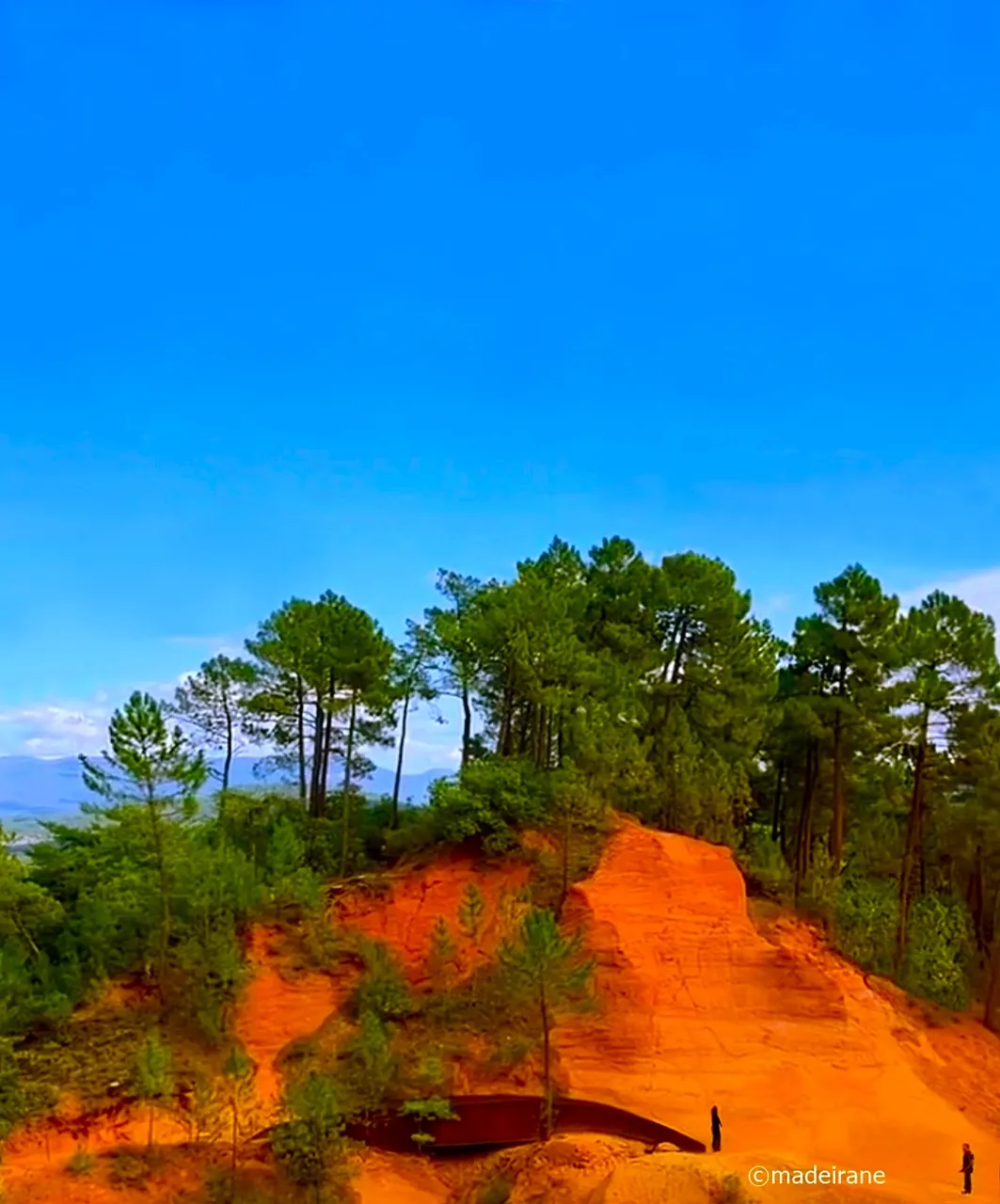
The hubby killed the troubadour, and ordered his heart to be cooked for dinner for his wife. When she ate lunch, he asked, “What did your lover’s heart taste like?” The countess proudly replied that it was so delicious that from now on she will never take anything else into her mouth, after which she took a step into the abyss right from the balcony. And her blood stained the rocks. Uh...
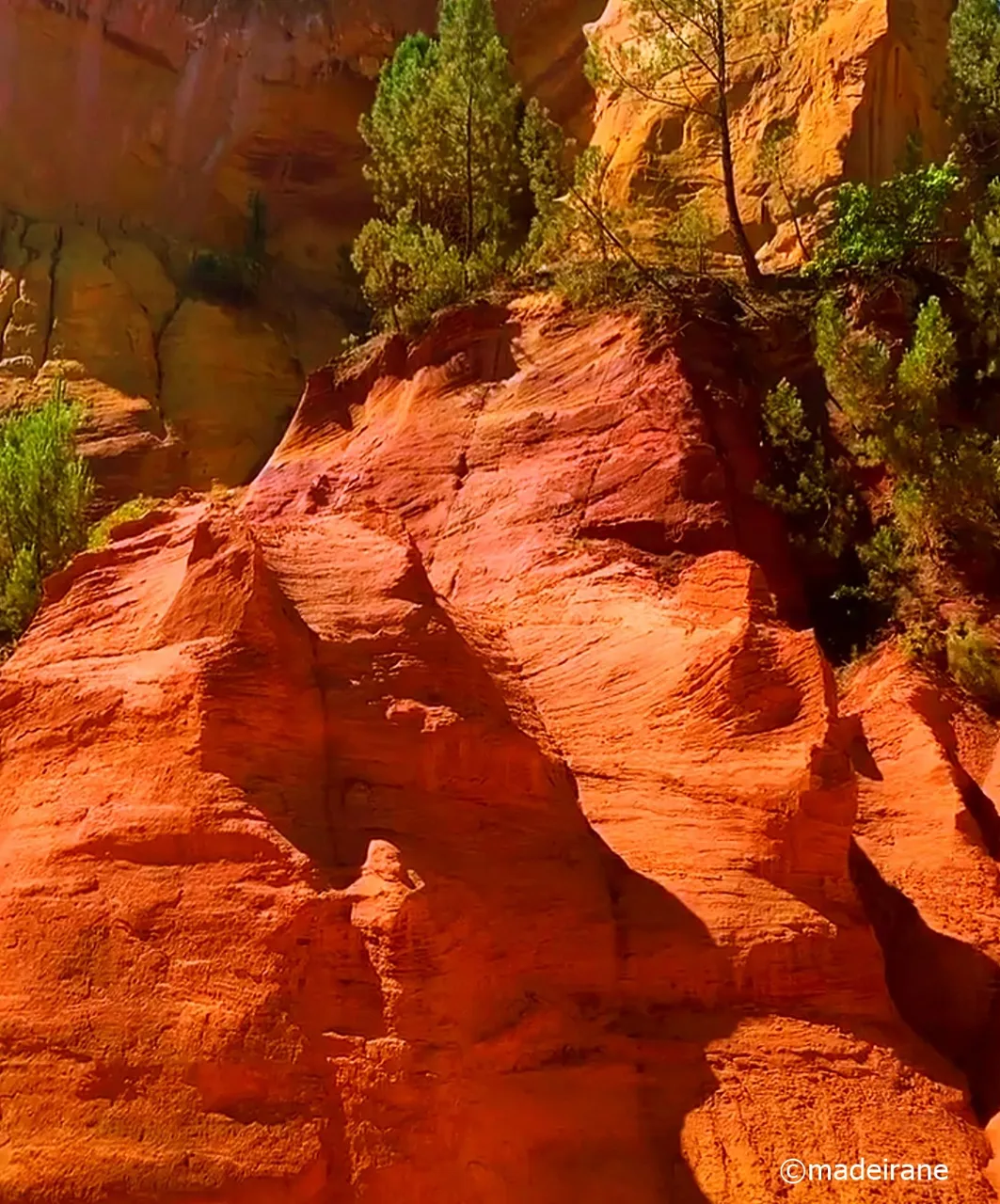
Probably, while leisurely walking along the orange path surrounded by rich greenery, you can feel like you are in a fairy tale. Yeah, I wish I could forget this bloody legend.
Alas, the landscapes contain dangers that we were not warned about. Even at the beginning of the journey, I noticed that many tourists were wearing disposable blue shoe covers, the kind that are usually given out in hospitals and clinics. I was surprised, but didn’t think about what this would be for... Later I understood. Since ocher is, by and large, not a dense clay, then from constant friction with the feet of tourists, the top layer of this clay (or ocher) turns into fine sand or even dust... It hangs in the air, settles on clothes, hair, face, but first - on shoes. It becomes covered with a thin (and sometimes not so thin) layer of bright orange dust. Shoes, of course, are easy to wash, but I don’t recommend going here in white sneakers or moccasins: fine reddish dust literally eats into the pores of light-colored shoes and washing them is very problematic.
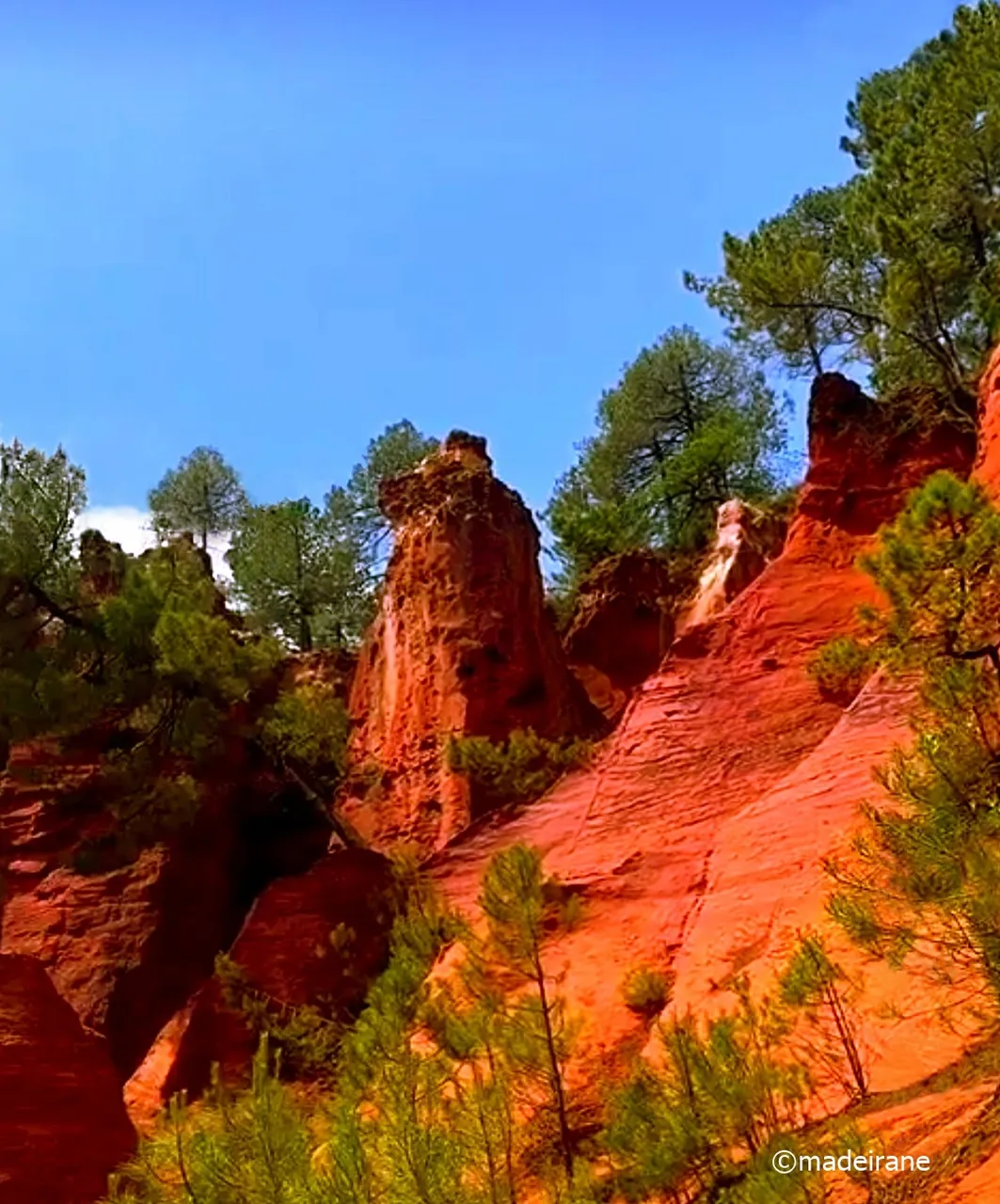
The cliffs not only have different colors, but also beautiful, bizarre drawings. It seems that this clay was laid by layers, blown by the winds, changing lines and bends because of this, and then such a miracle was obtained.

I read on one of the Internet sites that this place is also called “Provencal Colorado.” In appearance, the reserve, of course, bears little resemblance to the famous Grand Canyon in USA, Colorado, but in terms of the color of the cliffs and even their shape, there is definitely a similarity. The Ocher Nature Reserve is like the younger brother of the American Canyon.
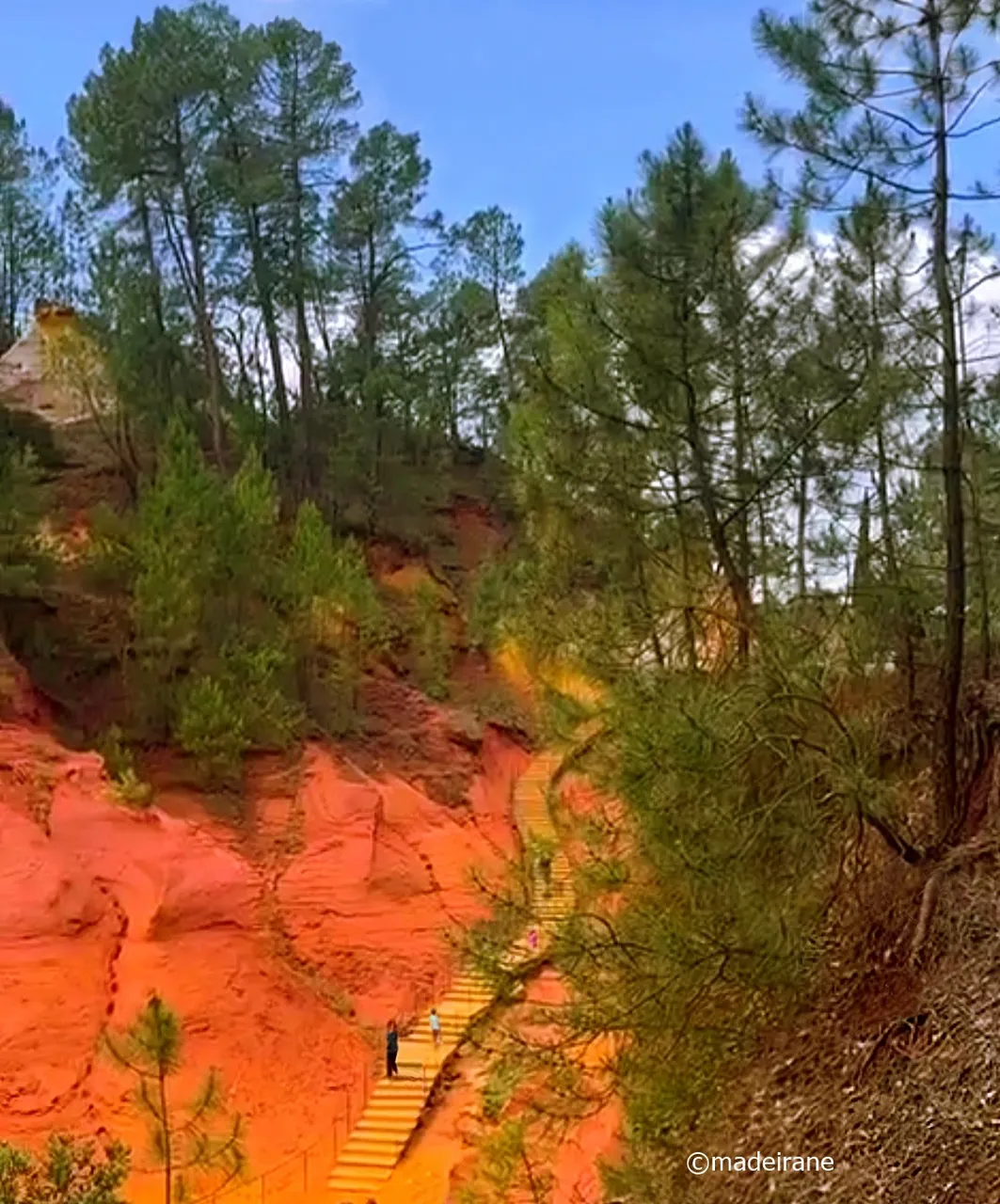
The main product obtained from ocher is paint. And therefore, in a small shop near the entrance to the reserve, it is presented in all colors, for every taste.
On the way back, we see several more rocks of unrealistic colors, although compared to the previous ones they look somehow faded.
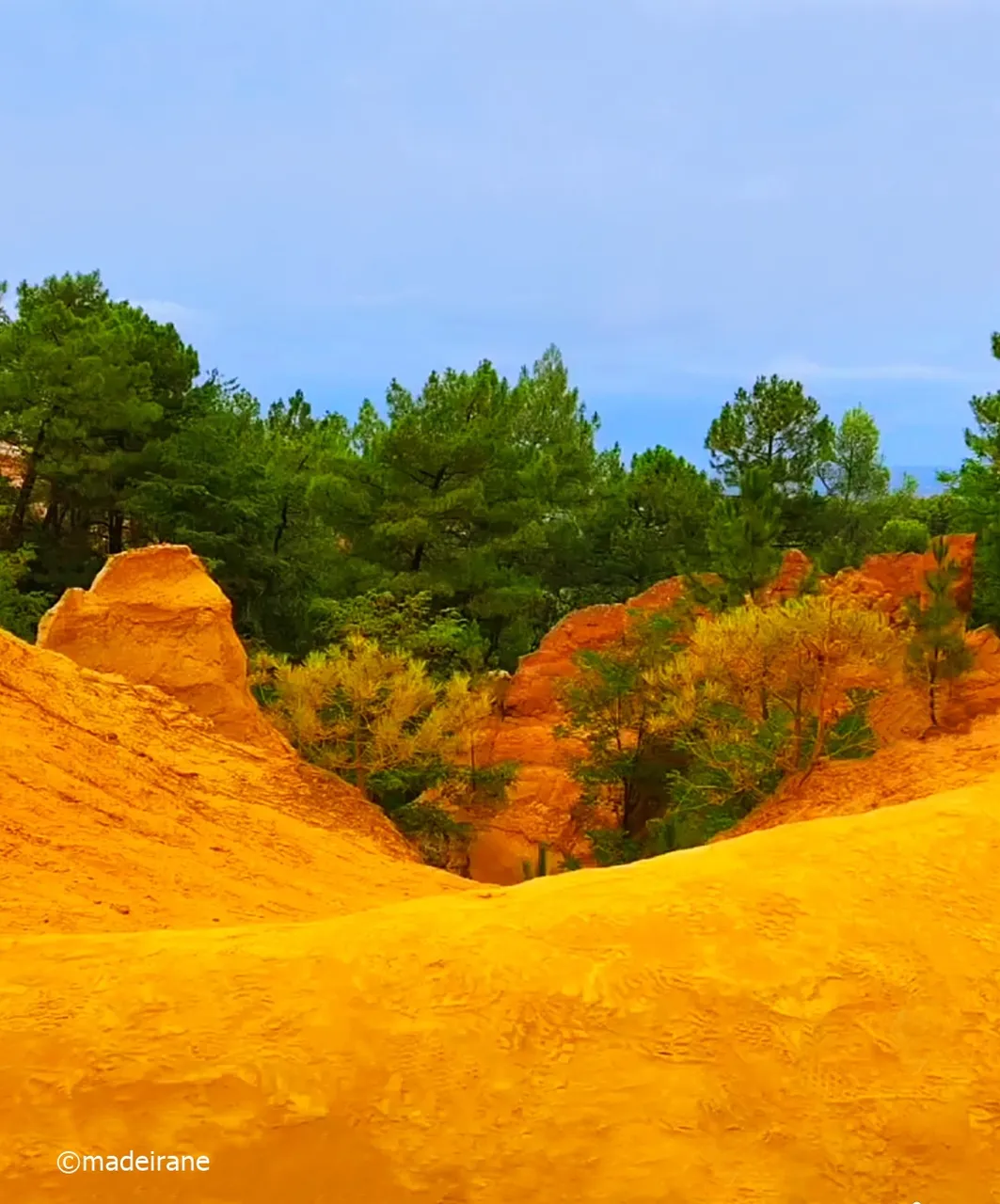
Here the contrast of red and green colors attracts the eye, and all sorts of bends, rises and unevenness of the landscape are simply mesmerizing. Dissonance involuntarily arises, it seems that nature has remained the same, deciduous and coniferous trees, bushes, flowers, pebbles underfoot, but at the same time there is a lot, a lot of red sand around. It was as if in some miraculous way we found ourselves in an alien civilization, on another planet.

Of course, the impressions from visiting the ocher reserve were most positive; the beauty was simply supernatural. Even if your trip is planned by the hour, even if you have absolutely no time, even if you are hungry and tired, you must visit the ocher reserve.
💝💝💝💝💝💝💝💝💝💝
With love @madeirane
Photos are taken by me.
© 2024
Translated from Lithuanian with DeepL.com (free version).
Apžiūrėję Penkiasdešimties Ochros Atspalvių miestą Roussillon, nuvykome į pačiame miesto pakraštyje esančius raudonio karjerus. Ir jei kurioje nors nuotraukoje ar atviruke pamatysite raudonai oranžines uolas ryškiai žalių pušų fone, žinokite, kad tai tikriausiai yra Provanso Ochros rezervatas.
Kadaise čia tiesiog buvo karjerai, kuriuose buvo kasama ochra - garsusis mineralinis pigmentas nuo šviesiai geltonos iki rusvai geltonos spalvos. Jis dar vadinamas rudąja geležies rūda. Ochra paprastai yra geležies hidrato oksido ir molio mišinys. Iš esmės natūrali ochra yra geltona, tačiau raudona ochra gaunama deginant geltoną ochrą.
Viena automobilių stovėjimo aikštelė yra arčiau Roussillon kaimo, kita - arčiau įvažiavimo į rezervatą - čia svarbu nesuklysti, nes nuo vienos stovėjimo aikštelės iki kitos reikia eiti apie 30 minučių!
Beje, prie įėjimo į Ochros rezervatą dalijamoje brošiūroje taip pat rašoma, kad tame pačiame regione, netoli karjero, yra senas ochros pigmento gamybos fabrikas. Visi susidomėjusieji taip pat gali apsilankyti. Šiuo klausimu negaliu nieko patarti, nes apsiribojome tik trumpa Roussillon miestelio ir paties rezervato apžiūra.
Visos šios uolos yra išlikusios iš buvusių karjerų, kuriuose daugelį metų, nuo XVIII a. iki 1930 m., buvo kasama ochra. Beje, tai buvo didžiausi ochros karjerai Europoje, tačiau atsiradus šiuolaikiniams akrilo ir kitiems sintetiniams dažams, ochros gavyba sumažėjo, o vėliau visiškai išnyko. Siekdama paremti ir finansuoti Roussillon miestą, vietos valdžia apleistą kanjoną pavertė turistų traukos centru. Iki šiol ši provincija traukia turistus, norinčius apžiūrėti ne tik ochros draustinį, bet ir šalia esantį miestelį.
Perkame bilietus, praeiname pro turniketus ir atsiduriame nepaprasto, hipnotizuojančio grožio vietoje. Pirmą kartą žvilgsnį į karjerą galima užmesti nuo Roussillon kelio. Jei neturite daug laiko, patarčiau geriau praleisti ekskursiją po miestą, nes karjerai pasirodė daug, daug įdomesni ir nuostabesni!
Perkant bilietus kiekvienam lankytojui duodamas žemėlapis, kuriame pažymėti maršrutai. Iš viso jų yra du: geltonasis ir raudonasis. Geltonasis maršrutas yra trumpesnis, raudonasis atitinkamai ilgesnis ir seka iš geltonojo, būdamas jo harmoninga tąsa. Jei pasirinksite ilgąjį raudonąjį maršrutą, pasivaikščiojimas neužtruks ilgai, daugiausiai 30-40 minučių neskubant.
Taigi žemyn veda laiptai, padengti oranžinėmis dulkėmis. Iš jo būtų pavykusi pati stebuklingiausia nuotrauka, jei ne nekantrūs turistai, spaudžiantys iš paskos. Takas vingiuoja tarp kalvų ir medžių, kurių kamienai padengti raudona danga.
Leidomės laiptais žemyn girdėdami susižavėjimo oho ir aha. Vienoje pusėje - raudona uola, kitoje - uola, kurioje susipina oranžiškai raudonos ir sodriai žalios spalvos. Pačiame viduryje smėlis toks ryškiai oranžinis, kad sunku patikėti.
Roussillon ochros draustinio unikalumas slypi būtent tame, kad čia galima pamatyti šviesiai geltonos, tamsiai geltonos, oranžinės, rausvos, rausvos, raudonos ir net raudonai rudos ochros. Spalvų įvairovė stebina, o šių ochros kalvų ir uolų formos primena kažką iš kosminės odisėjos ar fantastinių filmų siužetų. Susidaro įspūdis, kad atsidūrėte raudonojoje Marso planetoje.
Sena legenda byloja, kad šiose vietose seniai seniai gyveno kažkoks trubadūras. Jis įsimylėjo grafo žmoną. Pora ilgai negalėjo slėpti savo santykių, ir jos vyras sužinojo apie išdavystę.
Vyrukas nužudė trubadūrą ir liepė jo širdį išvirti žmonos vakarienei. Kai ji valgė pietus, jis paklausė: „Koks tavo meilužio širdies skonis?“ Grafienė išdidžiai atsakė, kad ji buvo tokia skani, kad nuo šiol ji niekada daugiau nieko neims į burną, po to žengė žingsnį į bedugnę tiesiai iš balkono. Jos kraujas nudažė uolas. Uh...
Tikriausiai neskubėdamas vaikščioti oranžinės spalvos taku, apsuptas sodrios žalumos, gali pasijusti tarsi pasakoje. Taip, norėčiau pamiršti šią kruviną legendą.
Deja, kraštovaizdžiuose slypi pavojai, apie kuriuos nebuvome įspėti. Jau kelionės pradžioje pastebėjau, kad daugelis turistų dėvėjo vienkartinius mėlynus batų užvalkalus, tokius, kokie paprastai dalijami ligoninėse ir klinikose... Nustebau, bet nepagalvojau, kam tai galėtų būti skirta. Vėliau supratau. Kadangi ochra iš esmės nėra tankus molis, tai nuo nuolatinės trinties su turistų kojomis viršutinis šio molio (arba ochros) sluoksnis virsta smulkiu smėliu ar net dulkėmis... Ji pakimba ore, nusėda ant drabužių, plaukų, veido, bet pirmiausia - ant batų. Jis pasidengia plonu (o kartais ne tokiu plonu) ryškiai oranžinių dulkių sluoksniu. Avalynę, žinoma, lengva nuplauti, tačiau nerekomenduoju čia eiti avint baltus sportbačius ar mokasinus: smulkios rausvos dulkės tiesiog žeria šviesių batų poras ir juos skalbti labai problemiška.
Uolos ne tik skirtingų spalvų, bet ir gražių, keistų piešinių. Atrodo, kad šis molis buvo klojamas sluoksniais, pučiamas vėjų, dėl to keitėsi linijos ir vingiai, o paskui gautas toks stebuklas.
Vienoje interneto svetainėje perskaičiau, kad ši vieta dar vadinama Provanso Koloradu. Savo išvaizda rezervatas, žinoma, mažai panašus į garsųjį Didįjį kanjoną JAV, Kolorado valstija, tačiau kalbant apie uolų spalvą ir net jų formą, panašumo tikrai yra. Ochros draustinis yra tarsi jaunesnysis Amerikos kanjono brolis.
Pagrindinis iš ochros gaunamas produktas yra dažai. Ir todėl nedidelėje parduotuvėlėje prie įėjimo į rezervatą jie pateikiami visų spalvų, kiekvienam skoniui.
Grįždami atgal pamatome dar kelias nerealių spalvų uolas, nors, palyginti su ankstesnėmis, jos atrodo kažkokios išblukusios.
Čia akį traukia raudonų ir žalių spalvų kontrastas, o įvairūs posūkiai, pakilimai ir kraštovaizdžio nelygumai tiesiog hipnotizuoja. Nevalingai kyla disonansas, atrodo, kad gamta išliko tokia pati, lapuočiai ir spygliuočiai medžiai, krūmai, gėlės, akmenukai po kojomis, bet kartu aplink daug, labai daug raudono smėlio. Tarsi kažkokiu stebuklingu būdu atsidūrėme svetimoje civilizacijoje, kitoje planetoje.
Žinoma, įspūdžiai iš apsilankymo ochros rezervate buvo patys geriausi; grožis tiesiog antgamtinis. Net jei jūsų kelionė suplanuota pagal valandas, net jei visiškai neturite laiko, net jei esate alkani ir pavargę, privalote aplankyti ochros rezervatą.